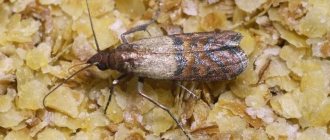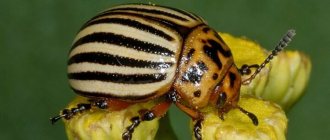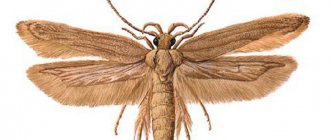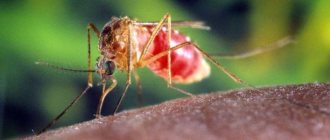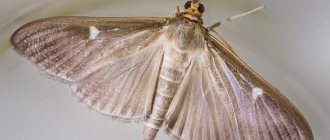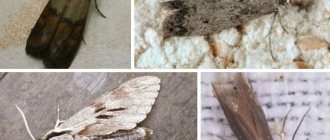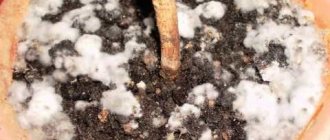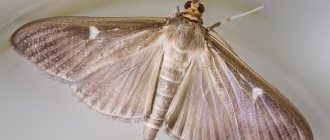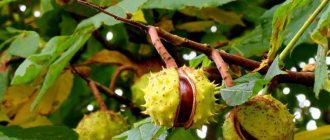The main pest is the larva of the food moth. The moth that appears in nuts is a moth, a butterfly, which in itself does not cause harm. Its caterpillars spoil the food. The sizes of insects may vary from each other.
It is difficult to remove moths from nuts because there is no universal remedy. Insecticides should not be used as they may spoil the products. In view of this, fighting insects becomes a labor-intensive undertaking.
Previously, moths preferred to feed on grass and trees. But with the development of human civilization, they gave preference to products. The insects quickly spread across the planet and began to attack kitchens and barns.
Description of the moth
food moth
A moth is an inconspicuous butterfly. There is a pattern on the wings of some species, but it is not noticeable. The sizes are small.
If there is a moth, it is quite difficult to see it. Sitting on the surface, it folds its 7 mm wings and becomes like a small protrusion.
Food moth is similar to clothing moth. The only difference is the habitat. Their larvae are also the same. Caterpillars do not have outgrowths or hairs. Color – white-pink or yellowish.
Important! Moth caterpillars do not seek to be seen.
They sit in food until pupation. Then they crawl out of the nightstands and crawl along the walls, at which time they can be noticed.
Why does moth start living in the house and how does it get into the apartment?
The most favorable living factors for this pest are:
- presence of twilight;
- constant access to food;
- room temperature for continuous life cycle.
And it can get into your home in several ways:
- Having flown over from the neighbors. Although the pest does not fly well and does not fly much, it is quite capable of covering short distances through ventilation openings or holes near heating pipes.
- Having flown over from the street. In search of food and for reproduction, they can easily fly into a house from the street.
- With contaminated food. If the manufacturer did not store their products correctly and did not pay attention to heat treatment, various food products may be contaminated with larvae. They are invisible to the eye, but once in a warm environment they begin to feed again and grow into an adult flying in search of a partner.
The most favorite “delicacies” for the pest are:
To avoid infection and spread of the pest, when purchasing the listed products, carefully inspect the packaging, and if there is the slightest presence of insects, do not take the product under any circumstances.
When you get home, transfer the contents of the package to an airtight food storage container. In this way you will prevent the pest from multiplying. The larvae are harmful primarily because they spoil food products.
By eating them, they leave behind numerous traces of their activity: eggs, husks, corpses, skins, feces. Yes, and there is a product that is infested with these insects, hardly anyone will want it; they will have to throw away the spoiled product completely.
And adult individuals are dangerous for humans only because they make new offspring, laying clutches in unexpected places.
What harm does a moth cause?
It won't take long for moths to show up in the kitchen.
Many people think that moths do not cause any significant harm. But this is not entirely true - its larvae are dangerous.
An adult can lay up to 500 eggs in a few days. Larvae emerge from them. They grow and shed their skin several times. As a result, the larvae clog the nuts with chitinous covering and feces. The consequences of taking such products can be disastrous:
- problems with immunity;
- intoxication;
- allergy.
Important! If there are moths in the kitchen, you should get rid of them as soon as possible.
Effective measures
To get rid of a butterfly, you need to know its biology. The mechanical method of dealing with an unsightly pest does not give the expected effect. While you are trying to destroy the pest with a sneaker, the caterpillars continue to develop.
To save the nuts, you will have to destroy:
- eggs;
- butterflies;
- larvae
Moth eggs are very small, their size does not exceed 0.5 mm. They are almost impossible to detect.
There is no seasonality; the parasite can appear indoors at any time.
You should start by fighting the larvae. They are the ones who spoil the nuts. To do this, products are sorted out and those that have become unusable are thrown away. You can learn about popular folk methods of fighting food moths by reading the corresponding article on our website.
Butterflies should be removed mechanically. Just press them down or install adhesive tapes.
Furniture cleaning
It is important to understand that if a butterfly appears, you will have to disinfect the entire area . Eggs can be located in the most inaccessible places. You'll have to get rid of them first.
Cleaning furniture from moths
In extreme cases, you can use chemicals. They are divided into:
- Plant-based repellents
- Eradication are insecticides that poison already emerging insects.
Insecticides are most often available in aerosol form. The most effective means:
- "Raptor" is used against butterflies and moth larvae. It is sprayed on wooden furniture, carpets and clothing. The effect lasts for a year or until the first wash.
- Aerosol "Combat" helps against most pests. It is enough to spray it on the joints of furniture, in corners and places where insects are located. The product is safe for animals.
- "Armol" has a long-lasting effect against larvae and an immediate effect against butterflies. Mainly used to protect carpets and furniture from parasites. The effect lasts for six months.
- Antimol is used on fabrics and clothing. The effect lasts until the first wash.
Important! Do not spray insecticides on nuts.
How to treat walnuts against pests in spring
If you treat a walnut tree before the growing season, you can avoid fruit falling due to pest damage. Even such a hardy crop needs protection. The best option for pest prevention is to spray the nut in early spring.
How to treat walnuts against sapwood in spring
Individual fruit trees may be affected by black beetle colonies. This is a parasite up to 4 millimeters in size with a black head and body, and brown elytra. You can see the bugs in early summer, when they choose their place of residence. Then the pests penetrate under the bark, starting to make moves in the wood, moving towards the buds.
Sapwood is dangerous for young plants, severely damaging fragile trunks. You can protect walnuts from pests by sanitary pruning of the crown. Dry shoots are often affected by sapwood.
The branches of the tree are also generously sprayed with insecticides. Up to two treatments are required per season. The first time this is done is after flowering ends, when the beetles emerge from their burrows in the bark.
When treating walnuts for sapwood, the following drugs are used:
- "Aktara" , 1.5 g.
- "Confidor" , 2.5 ml.
- "Mospilan" , 0.7 g.
The dosage is intended for dilution in 10 liters of water. After 14 days, the procedure is repeated. When spraying, the branches should be generously moistened with the solution. It is useless to do this after flowering, as the beetles will hide inside the tree.
Treatment of walnuts against walnut leafminer moths (speckles) in spring
Traces of the presence of the pest are dark tubercles on the foliage, which are called mines, which appear after caterpillars chew out parts of the leaf. In this case, the upper plate is not destroyed, but swells up like a tubercle.
The best option when treating walnuts against walnut leafminer moths (speckles) is the use of chemicals according to a given scheme:
- During swelling of the buds, spraying with the insecticide DDT (5.5%) or 12% Hexachlorane . The substances are poisonous, so 50 ml per bucket of liquid is enough.
- The event is repeated after the buds have broken.
- Another treatment is needed in the summer, when the next batch of caterpillars begins to appear (DDT only). All types of spraying are stopped a month before the crop ripens.
Professionals advise using modern biological preparations ( Entobacterin , Dendrobacillin, 50 g per bucket of water), operating at low temperatures (up to 25 degrees). They are diluted and used according to the instructions, processing two or three times.
What to do with walnut warty mites on walnuts in spring
At the first stage, the pest is difficult to notice. Only when spots appear on the leaves in the form of brown warts will there be any doubt about the lesion. Acaricides help get rid of ticks. There are drugs of natural or chemical origin. "Nisoran" refers to chemical compounds, used once a year. “Fitoverm” (1.5 ml per liter of water), “Vertimek” (1 ml per liter of water) are biological insecticides applied liberally to branches and leaves in case of damage.
The parasite is able to suck the juices out of the plant. Therefore, the fight against ticks requires an integrated approach. Preventive measures are carried out in early spring after the juices begin to flow. After some time, depending on the severity of the problem, another treatment is carried out. Can be repeated at certain intervals until the pest is completely destroyed. The second spraying should occur in May-June.
How to treat walnuts against aphids in spring
The pest is not only dangerous to the plant, but is also a carrier of fungal spores that infect branches and leaves. It is recommended to spray the infected tree with insecticides “Decis” (5 ml/bucket of water), “Karate Zeon” (4 ml/10 liters of liquid). Parasites with such contact die within half an hour. But these are adults, the eggs remain unharmed - the chemicals do not affect them. After a while, it will be necessary to carry out new processing. It is not recommended to water flowering trees with chemicals, as this causes the death of beneficial insects that pollinate the flowers. The number of sprays depends on the size of the aphid colony. It is recommended to use solutions of “Lepidocide” or “Pyrethroid” in the dosage indicated on the package (usually a 3-5% solution is prepared).
Processing walnut from white American butterfly in spring
The white butterfly lays larvae on the leaves of the crop. The caterpillars emerging from them feed on the succulent greenery, destroying all the foliage. Parasites are especially active in late summer or early autumn. Branches covered with white cobwebs indicate severe damage.
Spraying before flowering begins will help eliminate damage and get rid of insects. It is not recommended to do this during flowering. It is better to use microbiological solutions such as “Lepidocid” (30 grams per 10 liters of water) or “Bitoxibacillin” (50 grams per 10 liters of liquid). The affected parts of the plant are cut out and burned. If necessary, treatment can be repeated after flowering.
What to do with the codling moth on a walnut in the spring
If the fruits begin to darken and fall off before ripening, there is evidence of damage by codling moth caterpillars. The caterpillar gnaws through the still soft shell and eats the fruit from the inside.
To protect the plants, they are treated with insecticides ( Aktellik , Kinmiks , Calypso ). Over the summer, two generations of pests appear, the latter capable of destroying the bulk of the crop. Fighting with chemicals helps get rid of parasites. The work is carried out all season using such means as “Coragen Expert Garden” . The first treatment is necessary during the laying of larvae. For 10 liters of water, 0.2 grams of the substance is required. Carry out two weeks after the plant blooms. Then two more sprayings are done every two weeks.
How to treat walnuts against bedbugs and beetles in spring
These pests can reduce tree productivity. To protect against them, use a concentrated soap solution (300 g of laundry soap per bucket of water). It is necessary to do 2-3 treatments. At the same time, after spraying the plant in the evening, you need to wash off the composition in the morning to avoid sunburn. The procedure is carried out at any time until the parasites completely disappear. Chemical compositions for treatment - “Agan” , “Iskra” (2 ml/liter of liquid). Used repeatedly.
Treating walnuts against worms in spring
Caterpillars of an insect such as a fruit fly get inside the fruit. Its offspring, actively developing, destroy the fruits, feeding on the core. In the spring, to protect against pests, the soil near the tree trunk is dug up with the introduction of tobacco dust. The leaves and bark are sprayed with preparations containing copper (Bordeaux mixture, Abiga-Pik ) in the proportions described in the instructions.
Subsequently, preventive treatment of the branches and bark of the plant is carried out. It is recommended to use “Confidor” (1 g/liter of water), which differs in the duration of protection, or “Intavir” (tablet/liter of liquid), which affects pests after the first treatment.
Features of prevention
“Hercules” porridge is one of the favorite breeding grounds for food moths
- Wipe down kitchen cabinets with vinegar. Use oils whose odor is unpleasant to insects.
- Clear out the rubble - get rid of old things. The trash can harbor a parasite that will eventually spread to the kitchen.
- Store nuts in a plastic container with a tight-fitting lid.
- Review your inventory periodically.
It is not the butterflies themselves that spoil the food, but the caterpillars. It is quite difficult to see parasites because they do not announce their appearance. The danger is that affected products can lead to serious health problems: allergies, decreased immunity, intoxication.
It is necessary to destroy insects in a comprehensive manner: eggs, butterflies and larvae. The use of insecticides is not recommended, as they can poison the food. If you follow preventive measures, parasites will not appear! At the same time, it is important to carry out timely sanitization not only in the kitchen, but also in other rooms.
Traditional methods of getting rid of insects
Moths do not like sharp and strong odors, so the following tips will help to prevent and combat them:
- Garlic. Peel the fresh garlic cloves and place 1-2 pieces in each container. The garlic smell from flour and cereals disappears quickly, but is a good deterrent to uninvited guests.
- Dried branches of geranium or sweet clover have a specific strong smell that the butterfly cannot tolerate. Use this method with caution in families where there are people suffering from allergies.
- Lavender. A fragrant branch can be placed in a closet; it perfectly scares away uninvited guests from the contents of kitchen cabinets.
- Wormwood, tansy, and rosemary have a similar effect.
- Fresh orange peels are often laid out in cabinets. Citrus fruits are very hostile to moths, and they will not breed or inhabit the area.
Reviews and comments
+3 Nit 09.10.2015 14:41 Yes, an unpleasant neighborhood. I recently bought 3 boxes of candied nuts, and they included moths as a free addition. When a couple of individuals flew out of one box, I looked through the others. As it turned out, food moths can safely exist in a tightly closed plastic container, wrapped in cling film, i.e. no air! The article is good, but it’s a pity that there is no information on how to rehabilitate the products. Maybe you can wash it or bake it in the oven?
Quote
0 Vyacheslav 10/09/2017 09:47 Yesterday I ate pine nuts and found a black larva covered with a white cobweb in them. At first I wanted to throw it away, but then I became interested and put it in a box. Today I checked - and there is a butterfly sitting there - very similar to the one shown here in the photo.
Quote
-1 Alexey 11/15/2017 14:39 Quoting Nit:
Yes, an unpleasant neighborhood. I recently bought 3 boxes of candied nuts, and they included moths as a free addition. When a couple of individuals flew out of one box, I looked through the others. As it turned out, food moths can safely exist in a tightly closed plastic container, wrapped in cling film, i.e. no air! The article is good, but it’s a pity that there is no information on how to rehabilitate the products. Maybe you can wash it or bake it in the oven?
Without what air? Yes, the air contained in this jar of moths will last for three years. Quote

